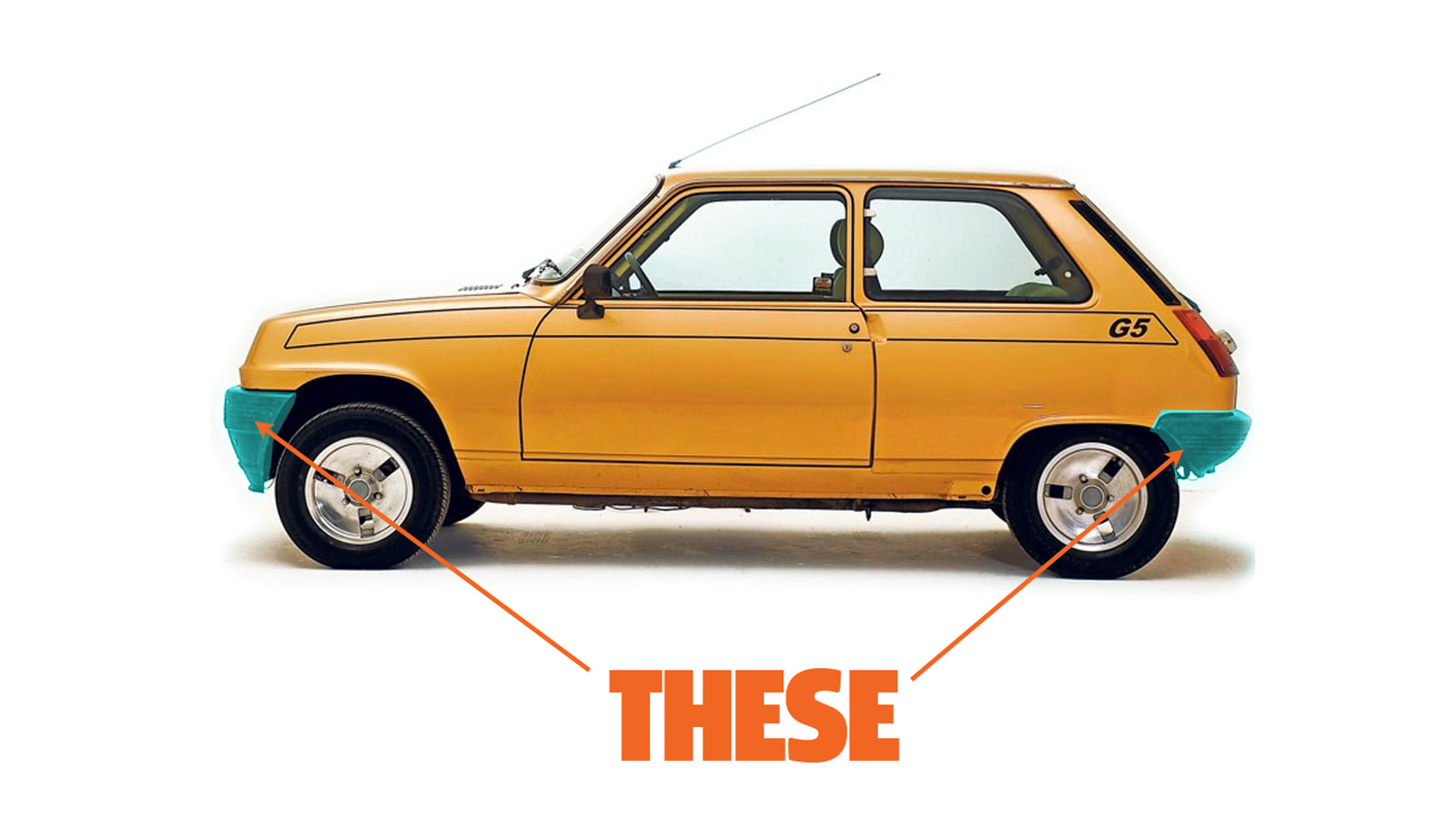The R7 also used chrome bumpers, which caused the design to lose one of its most influential details, the way the lower bits of the front and rear bodies were formed by he plastic bumper skins, something wildly common on car design today, but started by the humble R5. Look:
(image from Jalopnik, but made by me) In a way, I’m more surprised by the chrome bumpers than I am the tacked-on trunk. These R7s always look strange to me, but that didn’t phase nearly 160,000 mostly Spanish buyers, who all seemed to think that an extra pair of doors and a trunk was just what the R5 needed. The R7 was a car in the same general category as the Riley Elf, where an incredibly familiar shape gets a bigger butt grafted on, and the result isn’t bad, as such, but always looks a little, you know, off:
The longer I look at these, though, the less weird they seem. I guess that says something about the flexibility of the original, iconic shapes of these cars, that they can adapt so well to an extra chunk stuck on the rear? There were hatchback classic Minis, but they weren’t factory. https://www.hagerty.co.uk/wp-content/uploads/2021/03/Radford-hatchback-1024×663.jpg That could be a whole thing, since that’s also true of the square-front facelifts of the Ford Pinto and AMC Pacer, that the wagons wear them better than the others. It’s a shame they never built a wagon with the orignal R5 hatch and taillights at the end of the R7’s extra wheelbase and overhang. https://www.pinterest.ca/pin/772789617286137906/ I am surprised this wasn’t one of those posts making fun of the way people are posed. One of my R5s had an Alpine engine — courtesy of the previous owner — which was a neat little hemi-head unit that increased horsepower from 58 to 93. Unfortunately, he didn’t install the nice five-speed transaxle, the zoomy wheels or the more informative instrument cluster. He did add stiffer antiroll bars, wider tires and a couple of auxiliary gauges, though. That car was an absolute hoot to drive. Shocked the daylights out of drivers of a couple of local gray-market Golf GTIs. Until, that is, the cylinder head cracked (not an uncommon occurrence) and coolant mixed with oil. I wonder if the guy I sold it to ever managed to get the head repaired/replaced? Oh, and it was registered in California, something of a feat in the early 1980s. The guy who ran the smog checks at the neighborhood gas station had no idea what the smog plumbing of a LeCar should look like. He was satisfied when I told him the engine had all the smog stuff it left the factory with…. Spain has a tradition on those years about little cars with 4 doors. They made a 4 door variant of the Fiat 600, named the Seat 800. A bit longer, and with 4 door, made by an independent coach builder but sold as a SEAT model, on official dealers. They also made a 4 door version of the FIAT 850, with the same length than the 2 door and a longer one. SEAT also made a 4 door version of the FIAT 127 series one, that didn’t existed in Italy, so Fiat marketed them in Europe. They did also a 5 door version starting with the Series 2. The first series of the Renault 7 was called Renault Siete, seven in Spanish. They didn’t used numbers to accentuate it was a Spanish product. They are the ones with the square tail lights. The second series got the number 7 on the anagram, and rectangular bigger tail lights. Colors were the same of that time Renault 5. They never got the sporty engines of the R5, and used engines closer to the Renault 4. I have seen a Renault 7 that got the bumpers of the 5, and I like it. Incidentally, the race club of which I’m treasurer once had a young driver named Austin Kimberley, and he wasn’t hugely amused when I pointed out the coincidence. Integrated everything: basically a modern car Chrome bumpers: a car from the Before Times Non-integrated headlights: maybe my grandpa had one of those? Pontoon fenders: probably pre-WWII? Looks like a horse-drawn carriage without the horse: probably a Model T??? Anyway, I kind of miss properly styled chrome bumpers. The small nicks and bumps add up on the plastic (that is basically a body panel), whereas separated bumpers concentrated those events, handled them better and were easier to replace. And I well remember the first time I took a bumper cover off and found ‘styrofoam’. I was all, ‘I can’t even…’ a decade or more before that was a thing


